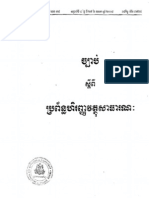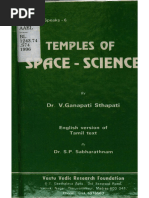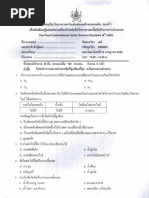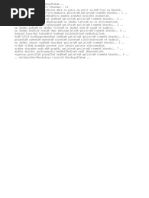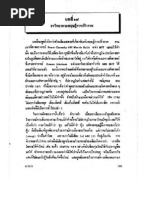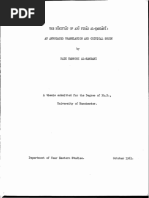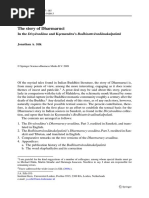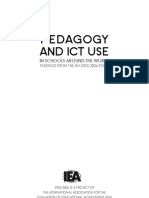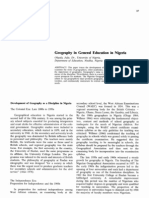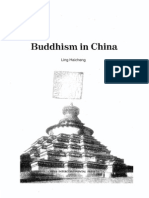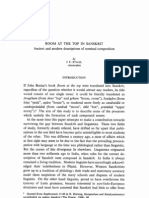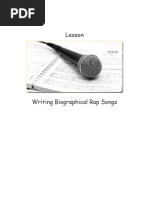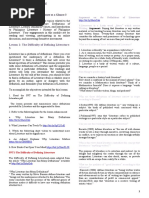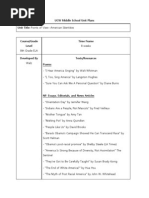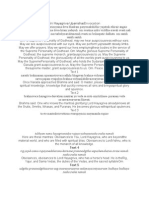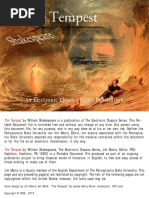Fragment of An Unknown Manuscript of Thesaddharmapundarīka From The N. F. Petrovsky Collection PDF
Fragment of An Unknown Manuscript of Thesaddharmapundarīka From The N. F. Petrovsky Collection PDF
Uploaded by
cha072Copyright:
Available Formats
Fragment of An Unknown Manuscript of Thesaddharmapundarīka From The N. F. Petrovsky Collection PDF
Fragment of An Unknown Manuscript of Thesaddharmapundarīka From The N. F. Petrovsky Collection PDF
Uploaded by
cha072Original Title
Copyright
Available Formats
Share this document
Did you find this document useful?
Is this content inappropriate?
Copyright:
Available Formats
Fragment of An Unknown Manuscript of Thesaddharmapundarīka From The N. F. Petrovsky Collection PDF
Fragment of An Unknown Manuscript of Thesaddharmapundarīka From The N. F. Petrovsky Collection PDF
Uploaded by
cha072Copyright:
Available Formats
F R A G M E N T OF A N U N K N O W N M A N U S C R I P T OF T H E
SADDHARMAPUN. .DARiKA
F R O M T H E N. F. PETROVSKY C O L L E C T I O N
by
G. M. BONGARD-LEVIN and E. N. TYOMKIN
Moscow
Leningrad
An unidentified fragment of a manuscript, written in upright Central Asian Br~hmi, is kept in the manuscript collection of the Leningrad Branch of the Institute of Asia of the USSR Academy of Sciences (Code: SI 6-~). The text is written in black Indian ink on a piece of yellowish paper 22 x 9.5 cm. The spacing is 1.5 cm. The size of characters is within the 1 x 1 cm limits, as a rule. The po.thi-type folio is only partially preserved and torn diagonally from the left to the top right angle. Along with other Buddhist texts this fragment was handed over to the former Asiatic Museum of the Russian Academy of Sciences by N. F. Petrovsky, who had acquired it in Kashgar in the 1890's. The text reads as follows: Recto: ... ... (III) ... (iv) ... (v) ... fro ... Verso:
(1~ . . .
(i) 0I)
ya.m k~gyapa buddhu bhe.syati, an~gate dhv~ni asa.mkhyi ip~rn.ako.tin~m, jin~nayam, drak.syati kggyapo hna pOj~.m dvipadottam~n~ .m sa te apratimo mahars.i.h iya.m suva ndha .m
(II~ ... hasrakot.a
(III) (IV) (V) (VI)
... ... ... ...
h~ni bhe.syam, ti sa dharmar~jina.h pramS.ha ye ~a antarakalpa sth~syati parip~rn.a vim. prabh~sasya viyQha bhes.yati 9 // atha khalv~yu
FRAGMENT OF AN UNKNOWN
Saddharmapun..darika-Ms.
269
270
G.M. BONGARD-LEVIN
and
E. N, TYOMKIN
FRAGMENT OF AY U ~ K N O W N
Saddharmapu.n.dar?ka-Ms.
271
,<
cq >-,
~A
',::1"
~2
d~
272
G.M. B O N G A R D - L E V I N
and E.
N. T Y O M K I N
t'q
t3
FRAGMENT OF AN UNKNOWN Saddharmapun..dafika-Ms.
273
In our opinion the text is a part of the Saddharrnapu~.dar~ka (chapter
v0.
The editors of the Saddharmapu.n.darika were not familiar with this fi'agment, which is a part of an unknown manuscript, and did not inelude it in their edition. The editors, H. Kern and Bunyiu Nanjio, along with other manuscripts, used the Kashgar manuscript of this text from the N. F. Petrovsky collection. 1 However, Prof. H. Kern, the well-known D u t c h scholar, overlooked some materials, among them folio 142 coinciding in its content with the fragment under review. H. Kern and Bunyiu Nanjio pointed out the absence of this folio in the Kashgar manuscript. 2 We were fortunate enough to discover, among the undescribed materials of the N. F. Petrovsky collection, a folio of the manuscript whose number was not preserved but which, as we have succeeded in establishing, is precisely folio No. 142 which was absent from the Kashgar manuscript? The size of the folio is 18 57.5 cm. The text is written in black Indian ink on a dark-yellow primed ruled piece of paper containing seven lines on each page. The size of characters is normally 1.5 1.5. The distance between the rules 2.5 cm. The left edge of the manuscript is damaged. Several initial characters are absent on each line. P Fragment SI 6-~' which, as has been mentioned above, is a part of an unknown manuscript of the Saddharmapu.n.dar~ka, and folio No. 142 of the Kashgar manuscript from the N. F. Petrovsky collection provide new readings for the verse part of the beginning of Chapter VI of the Saddharmapun..dar~ka. It appears relevant here to collate these texts with the critical edition of H. Kern and Bunyiu Nanjio taking into consideration the later Japanese edition as well? In spite of some differences between the readings of the Kashgar texts and those of the existing editions, the Kashgar manuscripts add a number of new, heretofore unknown variants important for the study of the 1 See Saddharmaput.~d.ar~ka (= Bibliotheca Buddhica, X), edited by Prof. H. Kern and Prof. Bunyiu Nanjio (St.-Pt., 1912), p. V. 2 Saddharmapu.n.darfka, p. 145. 3 Besides this folio, the undescribed materials of the N. F. Petrovsky collection contain more than 100 unnumbered folios of the Kashgar manuscript which, unfortunately, escaped the attention of H. Kern and other scholars who studied the text. 4 Wogihara U. and Tsuchida C., Kaitei Bonbun Hokeky6, Saddharmapu.nd.arikasgttram, Romanized and Revised Text of the Bibliotheca Buddhiea Publication (Tokyo, 1934-1935). Photomechanically reprinted in 1958. Thanks to the courtesy of Prof. J. W. de Jong we could familiarise ourselves with the necessary excerpt of the Japanese edition of this text. We are very grateful also to Mr. Akira Yuyama for his remarks on the readings of the text and on the notes.
274
G.M. BONGARD-LEVINand E. N. TYOMKIN
Saddharmapu.n.darika. The new variants are particularly valuable because the Kashgar manuscripts of the Saddharmapu.nd.ar~ka are much older than the Nepalese ones which were chiefly used by Prof. H. Kern and Prof. Bunyiu Nanjio in their edition. They contain a number of Prakritisms and cases of wrong Sanskritisation which are important for the study of the original text of the Saddharmapu.n.darTka. The influence-of Apabhram. ~a on the language of the Kashgar manuscripts can be traced. According to Prof. H. Kern, the Kashgar versions are more original than the Nepalese ones? It is quite evident that the scientific study of the Saddharmapun..darika should be based on the Kashgar manuscript from the N. F. Petrovsky collection and on the facsimile edition which the authors of the present note intend to publish in the nearest future. The first publisher of the text, Prof. H. Kern, considered the fulfilment of this task most desirable.
5 See Saddharmaputl.darika, ibid., p. IX.
T h e t e x t according to H . Kern a n d B u n y i u Nanjio's edition The p a g e s 141B a n d 1 4 2 A , B o f the K a s h g a r manuscript f r o m the N. F. P e t r o v s k y collection Fragment SI&
pagyfimyaham, bhik.sava buddhacak.sus.~ s t h a v i r o h y a y a m k ~ @ a p a b u d d h a bhes.yati / pagy~,myaha .m bhik.savaksava ~ buddhacaks.u.sS, s t h a v i r o hyayam, k~tgyapa b u d d h u ~ bhe.syate anO_gate dhv~ni 4 ... s a m k h y P k a l p e k r t v h n a b a h u ptija 6 t a t h f i g a t h n g m 7 tri .mga.msahasr~h. paripfirn.akot.i.., s ~m. j i n ~ n aya.m drak.syati k ~ g y a p o h y a y a m cari.syate 9 t a t r a ca b r a h m a c a r y a .m b o d d h a s y a ~ j f i g n a s y a . . . t e n a bhik.suh, n / 2 / k r t v ~ n a pf@.m dvipadottam~nO_mm ~ s a m u d ~ n i y a ~ j f i ~ n a m i d a .m h y a n u t t a r a m ~ sa ... fi~cayi 1~ l o k a n ~ y a k o ~6 bhavis.yat? r a p r a t i m o mahar.si? s [2/~ ks.etram, ca e t a s y a va ~ ... bhavis.yati vicitra p a r i g u d d h a ~a s u d a r g a n i y a m manojfiart~pa .m s a d a pren.maniyam. ~ s u v a . . , sgtrai s a m a l a m k r t a m ca /4/ r a t n g m a y ~ vrk.sa bahfininek59 ~ a.s.tgpadasmi tahi e k a ... m m a n o j f i a g a n d h a .m s a d a room. cam~nfi bhe.syamti k.setrasmi i m a s y a za b h i k s o ~s /5/ pus.paphale ~ p r a p h t a g v a b h r a ~s n a b h a v a .mti k.setre p r t h i v i ~9 s a . . . s y a t i darganiy~.h /6/ tahi b o d h i s a t t v f i n a s a h a s r a k o t . a y a ~. sudfintacitt~na ... h a r d d h i k f i n o vaitulyaZ~sOtrgntadhar~n.a t~yin~m b a h a n P z b h e s y a n t i sahasranekfi ... n~srav~ a n t i m a d e h a d h g r i . n o b h e s y a t i ss ye g r a v a k a dharmar~jina.h sa pramg.na ye za . . . h a kad~ci v i d y a t e d i v y e b h i cak.sObhi a6 gan. itva k a l p a ~7/8/ sa d v g d a g a as a n t a r a k a l p a sth~syati p a ... p~r.na z9 vi .mgac ca s a d d h a r m a sthasyati prasthfisyati a pratirfipakan.a chparavim, ga s t M s y a t i r a . . . p r a b h ~ s a s y a viytqha bhes.yati /9/ a t h a k h a l v ~ y u s m ~ .mt al s t h a v i r a / / //. ...hasrako.ta ... hfini a2 bhe.sya .mti sa . . . . . . dharmar~jina.h ~ pram~,n, a ye 3~ ... malam, krta.m ca v i c i t r a p u s p h e b h i ~v s u g o b h a m ~ n a . m ...ndham. .... iyam. s u v a
... ya.m k g @ a p a b u d d h u z bhe.syati a n g g a t e d h v ~ n i asam. k h y i ~ .... ipf~rn, ako.tingm s j i n g n a y a m drak.syati k~gyapo . . . g n a paj~m, d v i p a d o t t a m ~ n ~ m , sa ...te 17 a p r a t i m o mahar.si.h
a n ~ g a t e 'dhvfini a s a g t k h y a k a l p e k r t v g n a p~j~ .m d v i p a d o t t a m ~ n g m // 1
t r i m gatsahasr~.h parip~rn.akot.yo jinfinaya .m d r a k s y a t i k h g y a p o h y a y a m /
cari.syati t a t r a c a b r a h m a c a r y a m , b a u d d h a s y a jfifinasya k.rtena b h i k . s a v a h / / 2
krtvfina paj~m, d v i p a d o t t a m ~ n a m samud~.niya jfi~namidam, a n u t t a r a m / sa pa~cime c o c c h r a y i l o k a n ~ t h o b h a v i s y a t e a p r a t i m o m a h a r . s i h / / 3
k.setra .m ca t a s y a pravaram, bhavi.syati vicitra g u d d h a m g u b h a d a r g a n i y a m /
manojfiarfipam, s a d a premat3iya.m suvar.nasfitraih, samalam, k.rtam c a / / 4
r a t n ~ m a y ~ vrk.sa tahi .m vicitr~ a st.apadasmi .m tahi e k a m e k e /
m a n o j ~ a g a n d h a .m ca v i m u f i c a m g n ~ b h e s y a n t i ks.etrasmi i m a s m i b h i k s . o / / 5 pu.spaprakhrai.h samala.mk.rtam ca vicitrapus.pairupa~obhitam, c a /
g v a b h r a p r a p a t h n a ca t a t r a santi s a m a .m givam, bhe.syati d a r g a n i y a m / / 6
tahi b o d h i s a t t v ~ n a sahasrako.tyal) s u d h n t a c i t t h n a m a h a r d d h i k h n ~ m /
vaipulyast~trfintadharg~)a tfiying .m bahfi b h a v i s y a n t i s a h a s r a n e k e / / 7
an~sravfi antimadehadh~rin, o bhe.syanti ye gr~.vaka d h a r m a r ~ j f i a . h /
pramg.nu tesgm, n a kadfici v i d y a t e d i v y e n a jfifinena ga.nitva k a l p ~ n / / 8
so d v h d a g a a n t a r a k a l p a I sthhsyati s a d d h a r m a vi .mg~,ntarakalpa s t h f i s y a t i /
... ga~s a n t a r a k a l p a sthfisyati paripfirn.a 3s vi.m ... p r a b h f i s a s y a viyt~ha b h e s y a t i 9 // atha khalvayu
pratirf~paka~cgntarakalpavi.mgati r a g m i p r a b h ~ s a s y a v i y ~ h a b h e . s y a t i / / 9
a t h a k h a l v a y u . s m g n m a h f i m a u d g a l y ~ y a n a . h sthavira ...
According to the Errata on page 492. Bhik.savak.sava instead of bhik.yava. Most probably, a copyist's mistake. Buddhu instead of buddha. It is noteworthy that this reading, characteristic of Buddhist Hybrid Sanskrit (BHS), is repeated in the two different manuscripts from Kashgar. Such a form is possibly a result of the influence of Apabhra .toga. H. Kern failed to note this reading and referred only to the manuscript of the Royal Asiatic Society. On forms like buddhu see F. Edgerton, Buddhist Hybrid Sanskrit Grammar and Dictionary, vol. 1.8.20. Folio 141 ends here. The dots before the text that follows designate the beginnings of lines which were not preserved on folio 142AB. " ~ In both Kashgar manuscripts asamkhyi is irregular Loc. Sg. of asa~.nkhya characteristic of BHS. The edition of H. Kern and B. Nanjio notes asamkhyeya and asa.mkhyeye (according to the manuscripts of the Royal Asiatic Society and Watters' manuscript). U. Woglhara and C. Tsuchida give no variants. See Edgerton, BHS, 1.8.59. Paja instead of classical p~jd.m. A BHS form, common in verses. See Edgerton, 1.9.19. with a reference to Mv. III. 140.23 : k!'tva ... p~tjajine.su; puja karoti; Gv. 215.3 : pravartayi pgja jindndm, 231.18. 7 The Kashgar manuscript of N. F. Petrovsky has tathdgata instead of dvipadottama. Judging by the absence of indications relating to this variant, the editors did not come across this reading in the manuscripts at their disposal.
~ Samuddniya; the long final a is obviously determined by the metre. The length of final a (d) is possible in BHS. ~4 Hyanuttaram instead of anuttaram is evidently caused by the metre; a.m is already long in BHS. 1~ ,,1-gcayi - ? in The Kashgar manuscript of N. F. Petrovsky has lokandyaka instead of lokandtha. In the manuscripts used by H. Kern and B. Nanjio this reading did probably not occur. The footnotes give no reference to other variants. The same in the Japanese edition.
Inst.P1. pu$pehi, Vedicpu.spebhis); divyebhi (in 8th ~loka) instead of divyena (according to H. Kern). This must be divyehi after Sanskritization: divyebhi. ~s Prapdtagvabhra instead of gvabhraprapdta must be a copyist's mistake. 2~ P.rthivi Nora. Sg. Fern. It is possible to restore sa[ma bhe]syati and dar~aniyd[.h]. In that case the translation would be slightly different from that based on the text of Kern's and Wogihara's editions: "And the land will be smooth and beautiful". ~0 The visarga is absent which is either due to the influence of the Prakrit which underlays the Gftthfts (see Kern, ibid., pp. X-XI) or to a copyist's mistake. The form kot.aya[.h] instead of the more regular kot.ya.h is most interesting and occurs in both Kashgar manuscripts. See Edgerton, 1.10.152-153; 10.162 with reference to kot.ya.h. 3i Vaitulya instead of the equivalent vaipulya adopted by H. Kern and B. Nanjio. H. Kern cited this reading in the list of variants characteristic of the Kashgar manuscript, p 32 The text of Fragment SI ~ coincides with the Kashgar manuscript. Bah~ni instead of bah~ adopted by H. Kern and U. Wogihara, Bah~ni is the restored Sanskritization of the regular bah~. Probably this reading has been chosen in order to restore the metre. 8a Bhesyati instead of bhe~yanti. This could have been possible in Buddhist Hybrid Sanskrit, but is contrary to the metre. Probably a mistake of the copyist. 34 The texts of tile Kashgar manuscripts coincide. The form dharmardfina.h is a Prakritic form, evidently a North-Western one. Both variants are metrically possible. a~ In our opinion it is necessary to restore pramd.na ye[sdm] na kaddci vidyate. The final a in pramS.ha instead of u is possible. See footnote 3. s~ The translation is: "divine eyes" instead of "divine knowledge". The metre is correct. 37 Buddhist Hybrid Sanskrit kalpd instead of regular kalpdn. 38 Instead ofdvdda~a in the edition of H. Kern and B. Nanjio. The Japanese scholars have suggested dvdda~o. The manuscript of Petrovsky and Fragment SI ~ confirm the variant adopted by H. Kern and B. Nanjio. 62A
39
8 Thanks to Fragment SI 6@Athe reading in folio 142A: kot.indm which " different from that accepted by H. Kern and U. Wogihara is restored. Both variants are possible in the context, although the agreement of the numerals with the adjoining words is different. The fact that both manuscripts textually coincide ctearly indicates that kot. indm must be the right reading. Cari~.yate instead of eari.syati results from the mixing of the middle and active voices in the Middle Indian period. H. Kern and U. Wogihara have i which is possible for BHS (see Edgerton 1.26.2) and which corresponds to the metre. The variant of the Kashgar manuscript atso corresponds to the metre. ~o Boddha instead of bauddha according to the editions of H. Kern and U. Wogihara. ~ The reading bhik.su.h corresponds to the metre. ~ The superfluous ~.n is a copyist's mistake.
17 In Fragment SI ~ -[bhavisya]-te which corresponds to the metre. The variants of H. Kern and U. Wogihara are correct. ~8 The absence of visarga, which is present in H. Kern's edition and in the fragment, is possibly a copyist's mistake. ~9 Sic in the manuscript. Possibly, a copyist's mistake. Should have been Numeral 3. ~0 The reading etasya allows to restore va[ra.rn], which corresponds to the metre. 2~ The edition of H. Kern and B. Nanjio points out that dubha is left out in the manuscript belonging to Ekai Kawaguchi (just as in the present manuscript). The authors of the Japanese edition follow the reading of H. Kern. In the N. F. Petrovsky manuscript the metre is correct. 2~ The copyist's mistake is evidently to be explained by a dialectal pronunciation. 23 BahOni instead of vieitrd. The second n in bahaninekd may be an intervocal prothetic consonant or bahfminekd is bahfmi " ~k24 hnasya (gen.) instead of Prakrit ima.mhi (loc.); the translations are slightly different: k.setrasmi imasmi "in this field"; k.setrasmi imasya "in his field". The first variant is preferable. Both variants are possible as far as the metre is concerned. 2~ Bhiks.o in both editions. See Edgerton, 1.12.63 for this place. A Buddhist Hybrid Sanskrit form resulting from the coincidence of the a- and u- declensions. In their comments on the word, H. Kern and B. Nanjio cited other possible emendations: bhik.sa.h or bhiksavo. The Kashgar manuscript of Petrovsky confirms the adopted variant. z6 It is possible to restore pu.spaphale[bhiO] [sa]mala.mk.rta.m by analogy, although it does not correspond to the metre. ~7 Irregular form pusphebhi from puspebhi. Pu.spebhi instead of puspais (Cf. Prakritic
Thanks to the text of Fragment SI ~ we can restore in the ninth line of folio 142B of the Kashgar manuscript parip~roa which corresponds to the metre. 4a Repetition: sthdsyati prasthdsyati. Probably a copyist's mistake. 41 So in MSS.
You might also like
- Bodhisattvabhumi.a Statement of Whole Course of The Bodhisattva - Being Fifteenth Section of Yogacarabhumi - Unrai Wogihara.1971Document519 pagesBodhisattvabhumi.a Statement of Whole Course of The Bodhisattva - Being Fifteenth Section of Yogacarabhumi - Unrai Wogihara.1971TRAN NGOCNo ratings yet
- Samskrtasubodhini. A Sanskrit Primer. (M.deshpande) (2007)Document471 pagesSamskrtasubodhini. A Sanskrit Primer. (M.deshpande) (2007)sktkoshas94% (49)
- Jan Gonda A Concise Elementary Grammar of The Sanskrit Language PDFDocument158 pagesJan Gonda A Concise Elementary Grammar of The Sanskrit Language PDFAroonwan KongmebholNo ratings yet
- Noble Truths, Noble Path: The Heart Essence of the Buddha's Original TeachingsFrom EverandNoble Truths, Noble Path: The Heart Essence of the Buddha's Original TeachingsRating: 4.5 out of 5 stars4.5/5 (5)
- Sri Parasara Samhita Hanuman Charitram Vol1Document438 pagesSri Parasara Samhita Hanuman Charitram Vol1jayahanumanji82% (17)
- The Bible and The BallotDocument1 pageThe Bible and The BallotDaveNo ratings yet
- AUTHORITY, ANXIY, and CANONDocument340 pagesAUTHORITY, ANXIY, and CANONcha072No ratings yet
- Wolfgang David Cirilo de Melo-The Early Latin Verb System - Archaic Forms in Plautus, Terence, and Beyond (Oxford Classical Monographs) (2007)Document432 pagesWolfgang David Cirilo de Melo-The Early Latin Verb System - Archaic Forms in Plautus, Terence, and Beyond (Oxford Classical Monographs) (2007)Safaa SaeidNo ratings yet
- Little Red Cap IocDocument1 pageLittle Red Cap IocTiegan BlakeNo ratings yet
- Passe SimpleDocument4 pagesPasse SimpleAnjel EnriquezNo ratings yet
- Skorupski, T. - Sarvadurgatiparisodhana Tantra (Vol. 2)Document146 pagesSkorupski, T. - Sarvadurgatiparisodhana Tantra (Vol. 2)the CarvakaNo ratings yet
- The Jāiminīya or Talavakāra Upaniṣad BrāhmaṇaDocument183 pagesThe Jāiminīya or Talavakāra Upaniṣad BrāhmaṇaKatherine SpessNo ratings yet
- ŚrīsahajasiddhiDocument24 pagesŚrīsahajasiddhicha072100% (1)
- Aje PDFDocument500 pagesAje PDFCitra Priski AbadiNo ratings yet
- Law of Public Finance System 2008 KhmerDocument40 pagesLaw of Public Finance System 2008 KhmerChin VaryNo ratings yet
- Temples of Space Science 1nbspedDocument290 pagesTemples of Space Science 1nbspedbumppy.bharathNo ratings yet
- Chapter 5Document63 pagesChapter 5Rawats002No ratings yet
- HBM1Document302 pagesHBM1Алесь ШлыкNo ratings yet
- महर्षि अरविंद के मतानुसार वैदिक मनो विज्ञानDocument298 pagesमहर्षि अरविंद के मतानुसार वैदिक मनो विज्ञानdindayal maniNo ratings yet
- Nagarakre Tagama Pararaton Calon-Arang Ramayana NagarakretagamaDocument16 pagesNagarakre Tagama Pararaton Calon-Arang Ramayana Nagarakretagamasheila100% (1)
- Arabic Manuscripts Cllection at University of Leeds 1-50Document68 pagesArabic Manuscripts Cllection at University of Leeds 1-50Axx A AlNo ratings yet
- 1921 Issue 1Document26 pages1921 Issue 1Chris Finley Bey50% (2)
- Hrănirea Albinelor-Ion MiloiuDocument59 pagesHrănirea Albinelor-Ion Miloiucos1970No ratings yet
- Chem and Solution Ijso Round1 2550Document10 pagesChem and Solution Ijso Round1 2550Jiranuwatthana JirasubtrakulNo ratings yet
- A Critical Study of The Verse Portion of MrchchakatikaDocument238 pagesA Critical Study of The Verse Portion of MrchchakatikaBindunath JhaNo ratings yet
- About Lorentz Transformations and TachyonsDocument4 pagesAbout Lorentz Transformations and Tachyonsherms12345No ratings yet
- DhammapadaDocument68 pagesDhammapadaTim Ta100% (1)
- Writing Teaching Theory: Process Oriented ApproachDocument12 pagesWriting Teaching Theory: Process Oriented ApproachvisvabharatiNo ratings yet
- Chumash Ono1996 oDocument191 pagesChumash Ono1996 ocecihauffNo ratings yet
- Panjabi ReaderDocument294 pagesPanjabi ReaderSal6530No ratings yet
- Sankara BhavanyashtakamDocument1 pageSankara BhavanyashtakamChandramouli SankaranarayananNo ratings yet
- Urdu MerterDocument82 pagesUrdu MerterImran HaiderNo ratings yet
- Wayman Alex TR Yoga of The GuhyasamajatantraDocument386 pagesWayman Alex TR Yoga of The GuhyasamajatantraHan Sang Kim100% (1)
- Hinduism at A GlanceDocument132 pagesHinduism at A GlanceSudhir SrinivasanNo ratings yet
- The Middle Persian Inscription of Kartīr at Naqš-I Rajab PDFDocument15 pagesThe Middle Persian Inscription of Kartīr at Naqš-I Rajab PDFcha072No ratings yet
- R:Rdxnir Nuoi D Uu1M Ij, 1Nu3I0 Nun Oan: Uu3Nfllafl71 17U KL Al DL: U in I) 7inglu D7:IonDocument14 pagesR:Rdxnir Nuoi D Uu1M Ij, 1Nu3I0 Nun Oan: Uu3Nfllafl71 17U KL Al DL: U in I) 7inglu D7:IonvisvabharatiNo ratings yet
- Ebül-Firaz - RumiyyeDocument326 pagesEbül-Firaz - RumiyyeTorebey GunaydınNo ratings yet
- VācārambhanamDocument5 pagesVācārambhanamcha072No ratings yet
- Tibetan Blockprints and Manuscripts in The Oriental Collection of The Hungarian Academy of SciencesDocument1,791 pagesTibetan Blockprints and Manuscripts in The Oriental Collection of The Hungarian Academy of SciencessktkoshasNo ratings yet
- How To Write JapaneseDocument170 pagesHow To Write JapaneseaarpeereaderNo ratings yet
- The Story of DharmaruciDocument49 pagesThe Story of DharmaruciBhavithavNo ratings yet
- Blezer, Henk - Kar Glin Zi Khro - A Tantric Buddhist ConceptDocument246 pagesBlezer, Henk - Kar Glin Zi Khro - A Tantric Buddhist ConceptCornissa Althaqua100% (2)
- 01Document323 pages01mukesh8981No ratings yet
- Lyotard, Marin, Nancy Et Al - of The Sublime - Presence in Question (SUNY)Document263 pagesLyotard, Marin, Nancy Et Al - of The Sublime - Presence in Question (SUNY)Aarnoud Rommens100% (1)
- Manten 66 HistoricalDocument27 pagesManten 66 Historicaljavicol70No ratings yet
- A Essencia PDFDocument169 pagesA Essencia PDFWatson CabreraNo ratings yet
- Baba Ram Rai JiDocument22 pagesBaba Ram Rai JiDr Kuldip Singh DhillonNo ratings yet
- Tucci 1935 A Propos The Legend of NāropāDocument13 pagesTucci 1935 A Propos The Legend of NāropāCyberterton4No ratings yet
- Evaluative ethno-historical bibliography of the Malecite IndiansFrom EverandEvaluative ethno-historical bibliography of the Malecite IndiansNo ratings yet
- Collected Works of C. G. Jung, Volume 19: General Bibliography - Revised EditionFrom EverandCollected Works of C. G. Jung, Volume 19: General Bibliography - Revised EditionNo ratings yet
- Descriptive Analyses of Piano Works: For the Use of Teachers, Players, and Music ClubsFrom EverandDescriptive Analyses of Piano Works: For the Use of Teachers, Players, and Music ClubsNo ratings yet
- Erotic Triangles: Sundanese Dance and Masculinity in West JavaFrom EverandErotic Triangles: Sundanese Dance and Masculinity in West JavaRating: 5 out of 5 stars5/5 (2)
- The Mahabarata of Krishna-Dwaipayana Vyasa - BOOK I - ADI PARVAFrom EverandThe Mahabarata of Krishna-Dwaipayana Vyasa - BOOK I - ADI PARVANo ratings yet
- The Influence of India and Persia on the Poetry of GermanyFrom EverandThe Influence of India and Persia on the Poetry of GermanyNo ratings yet
- CERC Studies in Comparative Education - Pedagogy and ICT Use PDFDocument325 pagesCERC Studies in Comparative Education - Pedagogy and ICT Use PDFcha072100% (1)
- History of Sanskrit Grammatical Literature in Tibet Vol IDocument372 pagesHistory of Sanskrit Grammatical Literature in Tibet Vol Icha072No ratings yet
- Geography in General Education in Nigeria PDFDocument7 pagesGeography in General Education in Nigeria PDFcha072100% (1)
- The Sanskrit Language An OverviewDocument134 pagesThe Sanskrit Language An Overviewcha072No ratings yet
- ASURA in Early Vedic ReligionDocument240 pagesASURA in Early Vedic Religioncha07267% (3)
- On The Meaning of Skr. (Pra) BhinnāñjanaDocument6 pagesOn The Meaning of Skr. (Pra) Bhinnāñjanacha072No ratings yet
- The Sanskrit Language An OverviewDocument134 pagesThe Sanskrit Language An Overviewcha072No ratings yet
- Note On VĀrsaganya and The Yogācārabhūmi PDFDocument4 pagesNote On VĀrsaganya and The Yogācārabhūmi PDFcha072100% (1)
- Varuna and DhrtarāstraDocument21 pagesVaruna and Dhrtarāstracha072No ratings yet
- B. S. Mardhekar, A Modern Marathi PoetDocument10 pagesB. S. Mardhekar, A Modern Marathi Poetcha072100% (2)
- Buddhism in ChinaDocument276 pagesBuddhism in Chinacha072No ratings yet
- Combined Methods in IndologyDocument26 pagesCombined Methods in Indologycha072No ratings yet
- Room at The Top in Sanskrit PDFDocument34 pagesRoom at The Top in Sanskrit PDFcha072No ratings yet
- Fragment of An Unknown Manuscript of Thesaddharmapundarīka From The N. F. Petrovsky Collection PDFDocument8 pagesFragment of An Unknown Manuscript of Thesaddharmapundarīka From The N. F. Petrovsky Collection PDFcha072No ratings yet
- On Śankara's Authorship of The Kenopani SadbhāsyaDocument23 pagesOn Śankara's Authorship of The Kenopani Sadbhāsyacha072No ratings yet
- Notes On The Aśokan Rock EdictsDocument11 pagesNotes On The Aśokan Rock Edictscha072No ratings yet
- Representation of The Planets in Indian Astrology PDFDocument19 pagesRepresentation of The Planets in Indian Astrology PDFcha072No ratings yet
- Tolkāppiyam On Intervocalic StopsDocument2 pagesTolkāppiyam On Intervocalic Stopscha072No ratings yet
- The Middle Persian Inscription of Kartīr at Naqš-I Rajab PDFDocument15 pagesThe Middle Persian Inscription of Kartīr at Naqš-I Rajab PDFcha072No ratings yet
- Some Features of Ceylon Tamil PDFDocument26 pagesSome Features of Ceylon Tamil PDFcha072No ratings yet
- The Intensional Character of Laksana and Samkara in Navya-NyāyaDocument11 pagesThe Intensional Character of Laksana and Samkara in Navya-Nyāyacha072No ratings yet
- Representation of The Planets in Indian Astrology PDFDocument19 pagesRepresentation of The Planets in Indian Astrology PDFcha072No ratings yet
- The Intensional Character of Laksana and Samkara in Navya-NyāyaDocument11 pagesThe Intensional Character of Laksana and Samkara in Navya-Nyāyacha072No ratings yet
- My Connection With The Hebrew Letter SamekDocument9 pagesMy Connection With The Hebrew Letter Samekmichael2d2masekNo ratings yet
- Analyze The Relationship Between Helena and Demetrius in Act 2, Scene 1 of A Midsummer Night's Dream.Document4 pagesAnalyze The Relationship Between Helena and Demetrius in Act 2, Scene 1 of A Midsummer Night's Dream.Khatidja AllyNo ratings yet
- Julius Caesar Project PaperDocument1 pageJulius Caesar Project Paperapi-242428546100% (1)
- Lesson+Idea Writing+Biograhical+Rap+LyricsDocument6 pagesLesson+Idea Writing+Biograhical+Rap+LyricsRob MitchellNo ratings yet
- Dream of The Red ChamberDocument611 pagesDream of The Red ChamberX1Y2Z4No ratings yet
- Humss - Cw/Mpig-I-11: Abuyog, Leyte S.Y. 2023-2024Document2 pagesHumss - Cw/Mpig-I-11: Abuyog, Leyte S.Y. 2023-2024William MoralesNo ratings yet
- Form 4 English Literature Marking SchemeDocument3 pagesForm 4 English Literature Marking Schememyco samNo ratings yet
- What Is Creative WritingDocument7 pagesWhat Is Creative WritingCollegesecond semNo ratings yet
- 2023 English FAL Gr12Document12 pages2023 English FAL Gr12amber45ngewuNo ratings yet
- Lesson 1: The Difficulty of Defining Literature-3: OVERVIEW Philippine Literature at A Glance-3Document6 pagesLesson 1: The Difficulty of Defining Literature-3: OVERVIEW Philippine Literature at A Glance-3Ricelle NOJADERANo ratings yet
- ENGLISH Point of ViewDocument12 pagesENGLISH Point of ViewElaine Gay MandaNo ratings yet
- Raghava Yadaviyam - Eng. TransDocument96 pagesRaghava Yadaviyam - Eng. Transjambuna100% (1)
- American Identities Unit PlanDocument16 pagesAmerican Identities Unit Planapi-130859276No ratings yet
- Arthuriana Volume 10 Issue 1 2000 (Doi 10.2307/27869517) LINDA A. MALCOR - ESSAYS On MERLIN Merlin and The Pendragon - King Arthur's DraconariusDocument12 pagesArthuriana Volume 10 Issue 1 2000 (Doi 10.2307/27869517) LINDA A. MALCOR - ESSAYS On MERLIN Merlin and The Pendragon - King Arthur's DraconariusNițceValiNo ratings yet
- Sri Hayagriva UpanishadInvocationDocument4 pagesSri Hayagriva UpanishadInvocationprantik32No ratings yet
- Songs PDFDocument8 pagesSongs PDFSas SatNo ratings yet
- Characteristics of Shakespearean Tragedy: by Schoology or The InternetDocument14 pagesCharacteristics of Shakespearean Tragedy: by Schoology or The InternetNaomi HeywardNo ratings yet
- The Tempest - ShakespereDocument61 pagesThe Tempest - ShakespereSubhrajyoti BanerjeeNo ratings yet
- Scott Fitzgerald The Great GatsbyDocument3 pagesScott Fitzgerald The Great Gatsbyjurgute2000No ratings yet
- On Imagery and SymbolismDocument4 pagesOn Imagery and SymbolismMARY ANN ILLANANo ratings yet
- MR Nobody NotesDocument3 pagesMR Nobody NotesRohaya SharifNo ratings yet
- Formalist Analysis of "A Beheading"Document2 pagesFormalist Analysis of "A Beheading"falak chaudharyNo ratings yet
- BAM Study Guide Throne of BloodDocument12 pagesBAM Study Guide Throne of BloodAnja Mas100% (1)
- Heaven If You Are Not Here On EarthDocument3 pagesHeaven If You Are Not Here On EarthmaazsclgmemoriesNo ratings yet
- Reinforced Concrete Structures Volume 1Document20 pagesReinforced Concrete Structures Volume 1Miguel Rivera Bejarano100% (1)
- Bharat BhavanDocument6 pagesBharat BhavanVedangi Kale100% (1)
- Rhythm Practice PoetryDocument1 pageRhythm Practice Poetryaahk3202No ratings yet















